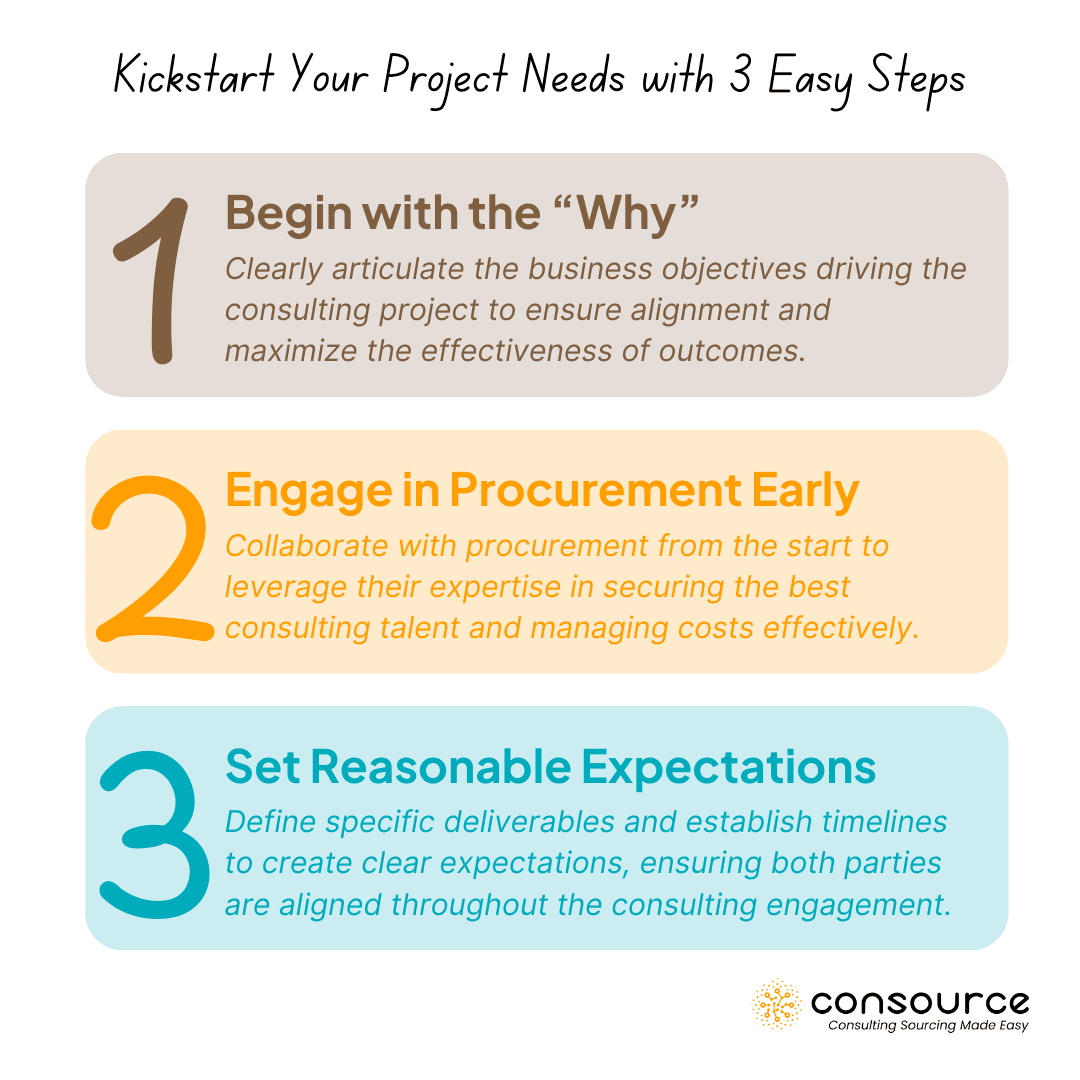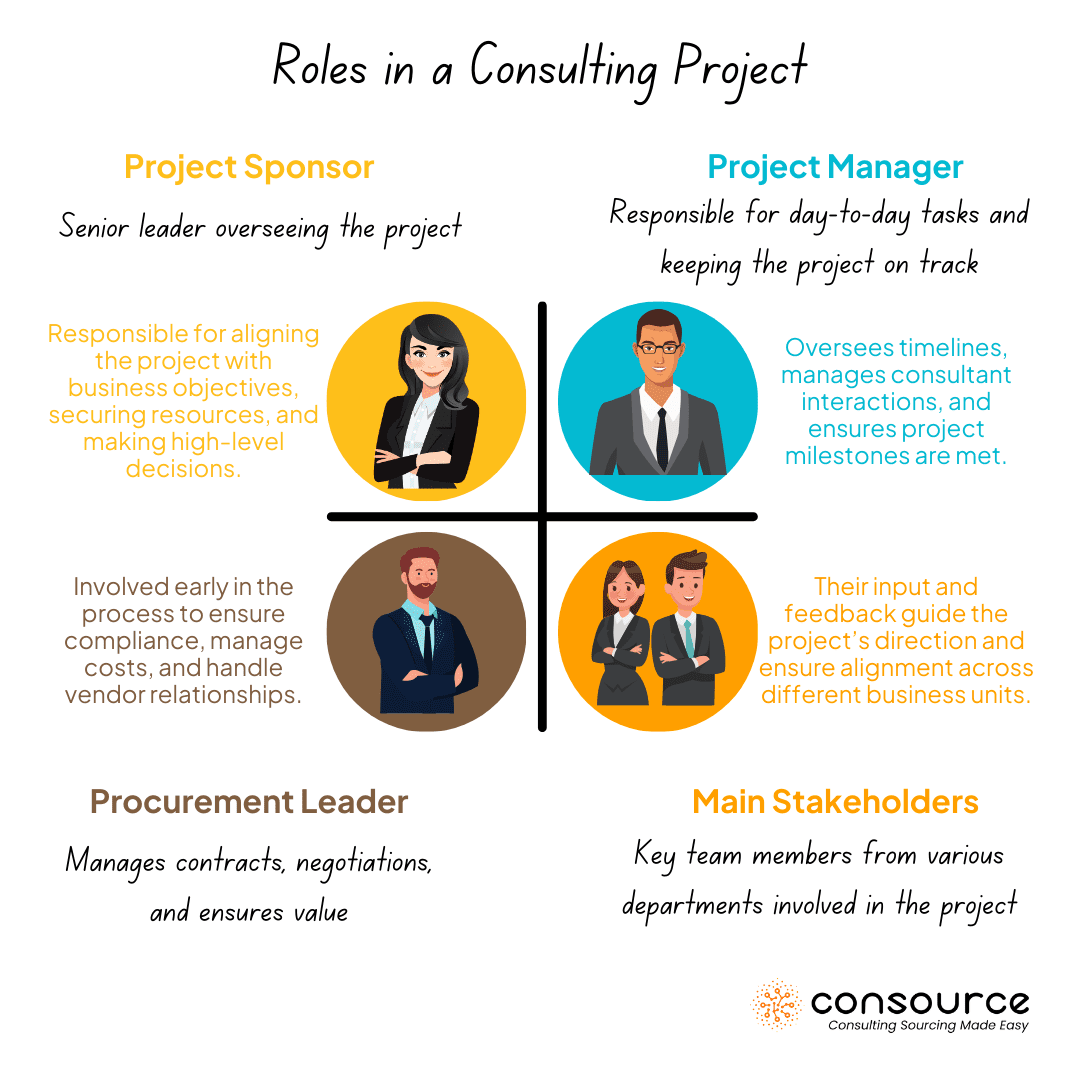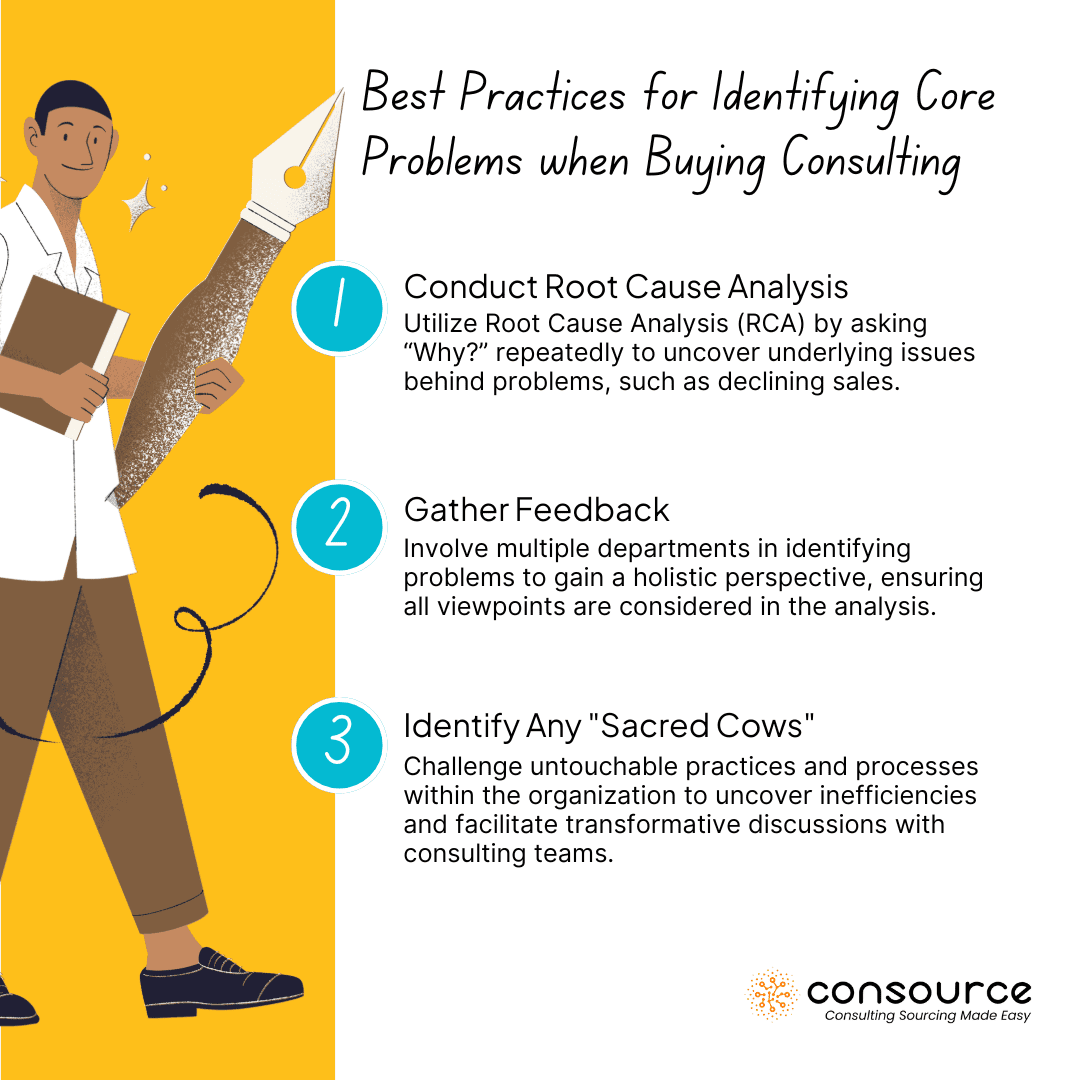Já enfrentou um desafio que deixou sua equipe sem saber qual seria o próximo passo? Você não está sozinho. Toda empresa - grande ou pequena - encontra obstáculos que exigem conhecimento externo. Entre nos serviços de consultoria: seu parceiro estratégico para resolver problemas complexos, otimizar operações e navegar pelas mudanças do mercado.
Mas aqui está o ponto crucial: se você não estiver preparado com uma visão clara e necessidades definidas, nem mesmo os melhores consultores do mundo poderão ajudar. Os serviços de consultoria são valiosos, mas sua eficácia depende em grande parte de o quanto você se prepara antes de trazê-los a bordo. É como contratar um chef de primeira linha sem lhe dar uma receita ou mesmo uma lista de ingredientes - os resultados podem variar.
Se você estiver lidando com uma transformação em toda a empresa ou apenas precisando de ajuda para simplificar as operações, este guia o orientará no processo de 10 etapas essenciais para a compra de serviços de consultoria que geram resultados.
Definição das necessidades do projeto: Estabelecimento do escopo e dos requisitos
Quando se trata de comprar serviços de consultoria, tudo começa com a definição de seu necessidades do projeto. Essa etapa é crucial porque estabelece a base para tudo o que vem a seguir - sem ela, você corre o risco de desalinhamento, de aumento de escopo e, por fim, de não conseguir atingir suas metas.

Comece com o porquê: O contexto comercial
Os compromissos de consultoria precisam ser enquadrados no contexto de seus objetivos comerciais. O que você está tentando alcançar com esse projeto? O objetivo é agilizar as operações, aumentar a receita, ou implementar novas tecnologias? Entender por que você precisa de serviços de consultoria é o primeiro passo para garantir que o projeto permaneça no caminho certo e produza resultados.
Por exemplo, imagine uma empresa que esteja buscando otimizar sua cadeia de suprimentos. Embora a meta geral possa parecer óbvia - melhorar a eficiência da cadeia de suprimentos - a necessidade real do negócio pode ser impulsionada por condições específicas do mercado, como as demandas dos clientes por entregas mais rápidas ou o aumento do custo das matérias-primas. Quanto mais claramente você articular a fatores empresariais subjacentesquanto mais personalizado e impactante for o seu contrato de consultoria.
Envolva o setor de compras desde o início: Comprar consultoria ainda é comprar
Aqui está uma etapa que muitas empresas ignoram: envolver aquisição desde o início. Sim, a compra de serviços de consultoria é fundamentalmente uma processo de compra-Você está comprando experiência e resultados, então por que não aproveitaria o conhecimento da sua equipe de compras? Os profissionais de compras são especializados em negociação de contratos, Gerenciamento de relacionamentos com fornecedorese garantir que sua organização obtenha o melhor valor possível para seu investimento.
O envolvimento do setor de compras desde o início ajuda a evitar armadilhas comuns, como gastos excessivos ou a seleção de consultores com base apenas na reputação e não na adequação. Eles também entendem as nuances de contratos de serviçoque muitas vezes diferem significativamente dos processos tradicionais de aquisição. Por exemplo, um profissional de aquisições pode garantir que você não esteja apenas comprando os melhores talentos, mas também que o escopo do projeto esteja claramente definido no contrato, evitando mal-entendidos dispendiosos no futuro.
Defina as expectativas em relação a entregas e cronogramas
Não é suficiente ter uma visão ampla do projeto de consultoria; você também precisa definir como é o sucesso em termos concretos. Você espera que os consultores entreguem um relatório estratégico abrangente? Eles serão responsáveis pela implementação de um novo sistema ou pelo treinamento da sua equipe? Seja claro sobre o que você quer que eles façam.
Igualmente importante é definir o linha do tempo. Quando você precisa desses resultados? Existem marcos importantes ao longo do caminho? Fornecer aos consultores um cronograma claro ajuda a gerenciar as expectativas de ambos os lados e garante que o projeto permaneça no caminho certo.
Identificando os principais problemas: Descobrindo as questões reais
Quando o panorama geral do projeto for estabelecido, a próxima etapa é aprofundar e identificar os problemas centrais que você precisa de ajuda para resolver. É nesse ponto que as empresas geralmente tropeçam, seja por não compreenderem totalmente o problema ou por se concentrarem demais nos sintomas em vez de nas causas básicas.
O perigo de confundir sintomas com problemas
Um dos maiores erros que as empresas cometem é confundir os sintomas com o problema real. Tomemos, por exemplo, uma empresa que está lutando contra a alta rotatividade de funcionários. A suposição inicial pode ser que os salários são muito baixos ou que o pacote de benefícios da empresa não é competitivo.
Embora isso possa ser verdade, A alta rotatividade também pode ser resultado de uma cultura de trabalho tóxicaA cultura da empresa é um problema de saúde, liderança ruim ou falta de oportunidades de desenvolvimento de carreira. Se você contratar consultores para resolver o problema errado - concentrando-se em pacotes de benefícios quando a verdadeira questão é a cultura - estará jogando dinheiro em um problema que não desaparecerá.
No mundo da consultoria, isso geralmente é chamado de diagnosticar antes de prescrever. Antes que os consultores possam prescrever uma solução, a empresa precisa trabalhar internamente para descobrir o que realmente está acontecendo de errado.
Práticas recomendadas para a identificação de problemas centrais
Aqui estão algumas estratégias para garantir que você esteja identificando os problemas reais:
#1. Conduzir a análise da causa raiz
Um dos métodos mais eficazes para identificar os principais problemas é Análise de causa raiz (RCA). A RCA ajuda as organizações a se aprofundarem nos problemas, perguntando "Por quê?" repetidamente até que a causa subjacente seja descoberta. Por exemplo, se as vendas estiverem diminuindo, perguntar por que as vendas estão baixas pode revelar problemas mais profundos, como baixa satisfação do cliente, estratégias de marketing desatualizadas ou ineficiências no funil de vendas.
#2. Obtenha feedback de toda a organização
Não confie apenas na visão de um departamento sobre o problema. Um trabalho de consultoria abrangente deve envolver o feedback de todos os departamentos relevantes. O que você vê como um problema em uma área pode ser sintoma de problemas em outra. Colaboração entre departamentos garante que você tenha uma visão holística do problema e pode ajudar a priorizar as áreas que precisam de mais atenção.
#3. Identifique quaisquer "vacas sagradas"
Toda empresa os tem: as práticas, os processos ou os departamentos intocáveis que ninguém quer questionar. Muitas vezes, essas "vacas sagradas" são exatamente as áreas que estão contribuindo para problemas mais profundos. Identificá-las e discuti-las abertamente com a equipe de consultores pode ser transformador. Os consultores geralmente conseguem identificar ineficiências ou práticas ultrapassadas com as quais as equipes internas se acostumaram demais.
Delegação de funções na equipe: As pessoas que fazem ou desfazem o projeto
O sucesso de um contrato de consultoria não se resume à identificação de problemas e à definição de resultados. Trata-se também de quem você envolve no processo. A equipe certa pode garantir que o projeto permaneça no caminho certo e que os consultores estejam trabalhando com pessoas que conhecem os meandros do negócio.
Principais funções em projetos de consultoria
#1. O patrocinador do projeto
Todo projeto de consultoria bem-sucedido precisa de um Patrocinador do projeto. Normalmente, trata-se de um executivo ou gerente sênior que tem autoridade para impulsionar o projetoO Patrocinador do Projeto é o responsável por tomar decisões importantes e garantir que o projeto se alinhe aos objetivos comerciais mais amplos. O patrocinador do projeto também atua como o principal ponto de contato para os consultores quando se trata de decisões de alto nível.
#2. O gerente de projetos
O Gerente de projetos é a pessoa que está no meio do mato todos os dias, garantindo que os consultores estejam entregando no prazo e que o projeto esteja avançando de acordo com o planejado. Enquanto o Patrocinador do Projeto lida com as decisões estratégicas, o Gerente de Projeto lida com as cotidiano responsabilidades, atuando como um elo entre os consultores e a equipe interna.
#3. Líder de compras
O Líder de compras desempenha um papel indispensável no gerenciamento da logística de compra de serviços de consultoria. Essa pessoa garante que os contratos sejam rígidos, que os consultores sejam examinados de forma justa e que a empresa obtenha o melhor valor possível do contrato. Sem um líder de compras forte, as empresas correm o risco de pagamento excessivo ou firmar contratos que não atendam a seus melhores interesses.
#4. Principais partes interessadas
Nenhum projeto de consultoria pode ser bem-sucedido sem a adesão de principais partes interessadas. Essas são as pessoas que serão diretamente afetadas pelo projeto e cujas as percepções são fundamentais para o seu sucesso. Quer se trate de chefes de departamento, líderes de equipe ou outros executivos, trazer as partes interessadas para a mesa de negociações desde o início garante que o projeto esteja abordando preocupações reais e tenha o apoio interno necessário para o sucesso.
Por que a dinâmica da equipe é importante
Os projetos de consultoria podem descarrilar devido à má comunicação ou à falta de alinhamento dentro da equipe. O gerente de projeto e o patrocinador devem garantir que todas as partes interessadas internas estejam na mesma página e que quaisquer discordâncias ou preocupações sejam tratadas com antecedência. Ao promover um ambiente colaborativo, você oferece aos consultores a melhor chance possível de sucesso.
Dica profissional: Faça check-ins regulares para manter todos os membros da equipe alinhados com o progresso do projeto e certifique-se de que todos os obstáculos sejam resolvidos antes que se tornem grandes obstáculos.

Conclusão: Comprando soluções, não serviços
No centro de todo contrato de consultoria está uma verdade crucial: você não está apenas comprando um serviço, está comprando uma solução para um problema. E é isso que torna a aquisição de serviços de consultoria tão diferente - e muito mais complexa - do que a compra de qualquer outro tipo de produto ou serviço. Os riscos são maiores porque o problema que você está tentando resolver geralmente está ligado diretamente às suas principais operações comerciais. Isso significa que acertar não apenas fornece uma solução, mas molda o futuro de sua empresa.
Mas aqui está o ponto alto: comprar uma solução exige mais do que apenas definir os requisitos. Trata-se de criar o ambiente adequado para a mudança, mesmo antes do início do projeto. É por isso que o processo de aquisição de consultoria está tão intrinsecamente ligado aos princípios de gerenciamento de mudanças. A mudança efetiva não acontece no final do projeto; ela começa desde o início - no momento em que você começa a definir suas necessidades. A forma como você engaja sua equipe, envolve as partes interessadas e define as expectativas pode ser decisiva para o sucesso de toda a iniciativa.
Envolver os principais participantes desde o início - sejam eles da área de compras, TI ou chefes de departamento - garante que as pessoas certas estejam na sala. Esses são os indivíduos que não só o ajudarão a enquadrar o problema corretamente, mas também a liderar o processo de implementação das recomendações do consultor.
É fácil pensar nos serviços de consultoria como uma transação: nós lhe damos dinheiro, você nos dá soluções. Mas é muito mais sutil do que isso. A consultoria é uma parceria, que envolve confiança, colaboração e visão compartilhada. O consultor certo pode agregar um valor incrível à sua organização, mas somente se as bases forem estabelecidas corretamente. E é por isso que criamos este guia - para fornecer a você as chaves para garantir que o seu contrato de consultoria não apenas permaneça no caminho certo, mas realmente transforme a sua empresa.
Ao seguir as etapas que descrevemos - desde a definição das necessidades do projeto e a identificação dos principais problemas até o envolvimento da equipe certa e o gerenciamento de mudanças - você se prepara para o sucesso. Porque, no final das contas, não se trata apenas de resolver o problema de hoje. Trata-se de construir uma base para o sucesso de longo prazo que esteja profundamente alinhada com o futuro de sua empresa.
Perguntas Mais Frequentes
Por que é tão importante definir as necessidades do projeto antes de contratar consultores?
Definir as necessidades de seu projeto é essencial porque estabelece a base para tudo o que vem a seguir. Sem necessidades claras do projeto, os consultores não saberão o que é sucesso e você corre o risco de obter soluções que não abordam verdadeiramente os desafios da sua empresa. É como construir uma casa sem plantas - você pode acabar tendo algo, mas não será o que você queria. Essa etapa garante o alinhamento entre as partes interessadas internas e os consultores, evitando mal-entendidos dispendiosos e desvios de escopo no futuro.
Como posso ter certeza de que estou escolhendo o consultor certo para o trabalho?
O consultor certo não é apenas alguém com um currículo impressionante - é alguém com a experiência e as habilidades adequadas ao seu problema específico. Comece identificando claramente suas necessidades e, em seguida, elabore uma RFP (Request for Proposal, Solicitação de Proposta) que capture essas necessidades em detalhes. Ao analisar os possíveis consultores, considere a experiência deles em enfrentar desafios semelhantes, a abordagem deles para a solução de problemas e a capacidade de trabalhar com a cultura da sua empresa. Não hesite em solicitar estudos de caso ou referências para confirmar sua eficácia. Uma boa adequação vai além do conhecimento técnico; trata-se de encontrar um parceiro que possa realmente se integrar à sua equipe.
Qual é a função do patrocinador do projeto no sucesso de um projeto de consultoria?
O patrocinador do projeto é a força motriz por trás do contrato de consultoria. Ele garante que o projeto permaneça alinhado com as metas mais amplas da empresa e tenha recursos suficientes. O patrocinador geralmente atua como uma ponte entre a equipe executiva e os consultores, defendendo o projeto e garantindo que quaisquer obstáculos sejam rapidamente removidos. Ele também fornece a autoridade necessária para tomar decisões de alto nível que mantêm o projeto em andamento. Em essência, o patrocinador do projeto garante que o projeto não se perca no meio de outras prioridades comerciais.
Preciso criar uma RFP (Request for Proposal) formal ao contratar consultores?
Embora uma RFP formal nem sempre seja necessária para projetos menores e diretos, ela é altamente recomendada para compromissos mais complexos. Uma RFP serve como um guia detalhado para possíveis consultores, descrevendo suas necessidades, objetivos e restrições específicos. Esse processo formal também ajuda a comparar os consultores em termos iguais, garantindo que todos os candidatos estejam respondendo ao mesmo conjunto de critérios. A longo prazo, uma RFP bem elaborada pode evitar falhas de comunicação e alinhar as expectativas, facilitando a seleção do melhor consultor para o seu projeto.
Posso mudar a direção do projeto depois que os consultores já tiverem começado?
Sim, mas tenha cuidado. As alterações no escopo do projeto - geralmente chamadas de "scope creep" - podem levar a atrasos e custos adicionais se não forem gerenciadas com cuidado. Se você identificar a necessidade de uma mudança, é importante discuti-la com o gerente de projeto e o patrocinador para avaliar seu impacto no cronograma e no orçamento do projeto. Todas as alterações devem ser claramente documentadas e comunicadas à equipe de consultoria para garantir que todos estejam na mesma página. A flexibilidade é fundamental, mas deve ser equilibrada com uma compreensão clara dos riscos envolvidos.
Qual é a diferença entre o patrocinador e o gerente do projeto e por que ambas as funções são importantes?
O patrocinador do projeto é responsável pela supervisão estratégica e por garantir que o projeto esteja alinhado com as metas mais amplas da empresa. Normalmente, é um líder sênior que tem autoridade para tomar decisões importantes, alocar recursos e resolver problemas de alto nível. O gerente de projeto, por outro lado, lida com a execução diária do projeto. Ele trabalha em estreita colaboração com a equipe interna e com os consultores para garantir que os cronogramas sejam cumpridos, os marcos sejam alcançados e o projeto permaneça em andamento. Ambas as funções são essenciais porque, enquanto o patrocinador se concentra na estratégia geral, o gerente de projeto mantém os detalhes práticos sob controle.
Para se aprofundar nas práticas recomendadas para a compra de serviços de consultoria, confira o artigo da Consulting Quest sobre Como comprar consultoria como um profissional. Ele fornece insights práticos para ajudá-lo a maximizar o valor de seus compromissos de consultoria.









0 comentários